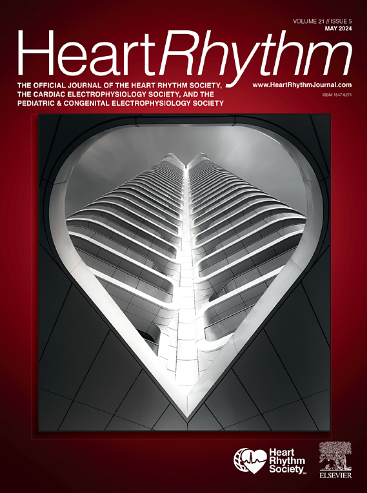心力衰竭和左室射血分数轻度降低患者心脏再同步化治疗中传导系统起搏与双心室起搏的比较:LBBAP 国际合作研究 (I-CLAS) 小组的研究结果。
IF 5.7
2区 医学
Q1 CARDIAC & CARDIOVASCULAR SYSTEMS
引用次数: 0
摘要
背景:心脏再同步化疗法是指南推荐的一种疗法,适用于心力衰竭、左室射血分数轻度降低(HFmrEF 36-50%)、左束支阻滞或有心室起搏指征的患者。利用左束支区起搏(LBBAP)或氦束起搏(HBP)进行传导系统起搏(CSP)已被证明是双室起搏(BVP)的一种安全且符合生理学原理的替代方法:本研究旨在比较接受 CRT 的 HFmrEF 患者在 BVP 和 CSP 之间的临床疗效:纳入2018年1月至2023年6月期间在16个国际中心接受BVP或CSP治疗的HFmrEF患者。主要结局为死亡或 HFH 时间的复合终点。次要终点包括 LVEF 的变化以及死亡和 HFH 的单个终点:共有 1004 名患者符合纳入标准:BVP 178例,CSP 826例(HBP 154例;LBBAP 672例)。平均年龄为 73±13 岁,女性占 34%,LVEF 为 42±5%。与 BVP 相比,CSP 的起搏 QRS 持续时间明显较窄(129±21 vs 144±19,p 结论:在接受 CRT 治疗的大量 HFmrEF 患者中,与 BVP 相比,CSP 可改善临床预后。有必要进行比较 CSP 和 BVP 的随机对照试验来证实这些结果。本文章由计算机程序翻译,如有差异,请以英文原文为准。

Conduction system pacing compared with biventricular pacing for cardiac resynchronization therapy in patients with heart failure and mildly reduced left ventricular ejection fraction: Results from International Collaborative LBBAP Study (I-CLAS) Group
Background
Cardiac resynchronization therapy (CRT) is a guideline-recommended therapy in patients with heart failure with mildly reduced ejection fraction (HFmrEF, 36%–50%) and left bundle branch block or indication for ventricular pacing. Conduction system pacing (CSP) using left bundle branch area pacing or His bundle pacing has been shown to be a safe and physiologic alternative to biventricular pacing (BVP).
Objective
The aim of this study was to compare the clinical outcomes between BVP and CSP for patients with HFmrEF undergoing CRT.
Methods
Consecutive patients who underwent BVP or CSP with HFmrEF between January 2018 and June 2023 at 16 international centers were included. The primary outcome was the composite end point of time to death or heart failure hospitalization (HFH). Secondary end points included change in left ventricular ejection fraction (LVEF) and individual end points of death and HFH.
Results
A total of 1004 patients met inclusion criteria: BVP, 178; CSP, 826 (His bundle pacing, 154; left bundle branch area pacing, 672). Mean age was 73 ± 13 years; female, 34%; and LVEF, 42% ± 5%. Paced QRS duration in CSP was significantly narrower compared with BVP (129 ± 21 ms vs 144 ± 19 ms; P < .001). LVEF improved during follow-up in both groups (49% ± 10% vs 48% ± 10%; P = .32). CSP was independently associated with significant reduction in the primary end point of time to death or HFH compared with BVP (22% vs 34%; hazard ratio, 0.64; 95% confidence interval, 0.43–0.94; P = .025).
Conclusion
CSP was associated with improved clinical outcomes compared with BVP in this large cohort of patients with HFmrEF undergoing CRT. Randomized controlled trials comparing CSP with BVP will be necessary to confirm these results.
求助全文
通过发布文献求助,成功后即可免费获取论文全文。
去求助
来源期刊

Heart rhythm
医学-心血管系统
CiteScore
10.50
自引率
5.50%
发文量
1465
审稿时长
24 days
期刊介绍:
HeartRhythm, the official Journal of the Heart Rhythm Society and the Cardiac Electrophysiology Society, is a unique journal for fundamental discovery and clinical applicability.
HeartRhythm integrates the entire cardiac electrophysiology (EP) community from basic and clinical academic researchers, private practitioners, engineers, allied professionals, industry, and trainees, all of whom are vital and interdependent members of our EP community.
The Heart Rhythm Society is the international leader in science, education, and advocacy for cardiac arrhythmia professionals and patients, and the primary information resource on heart rhythm disorders. Its mission is to improve the care of patients by promoting research, education, and optimal health care policies and standards.
 求助内容:
求助内容: 应助结果提醒方式:
应助结果提醒方式:


